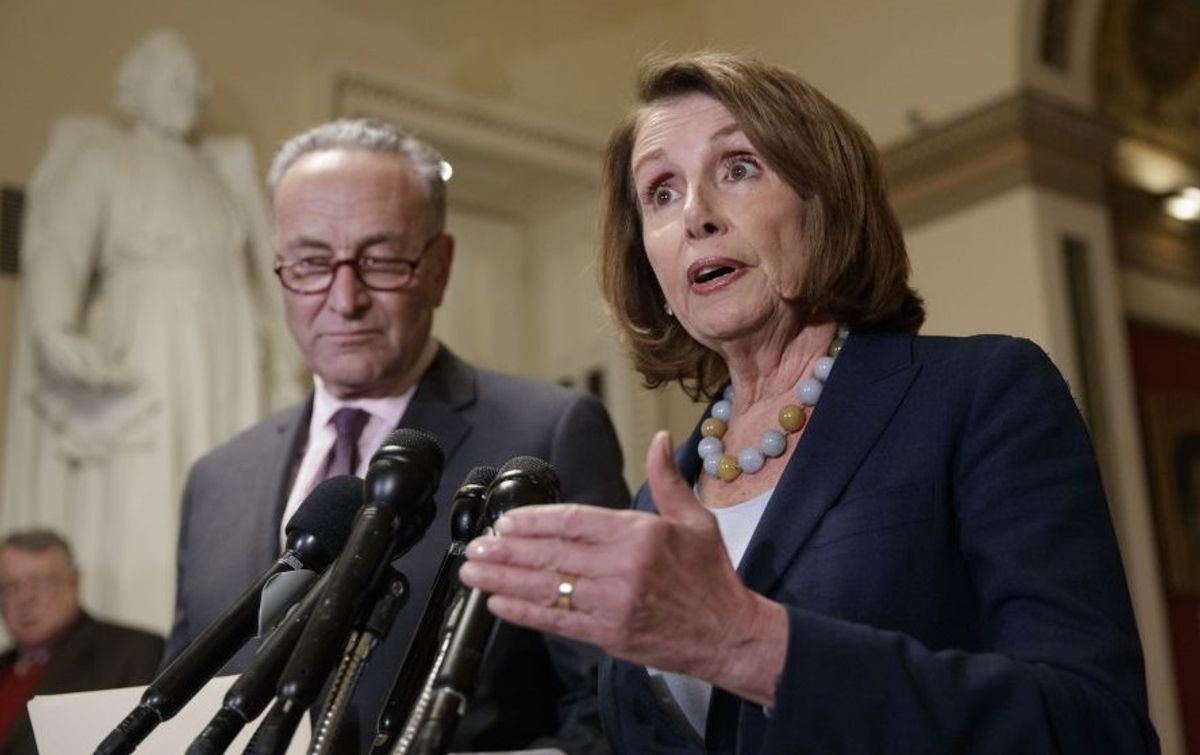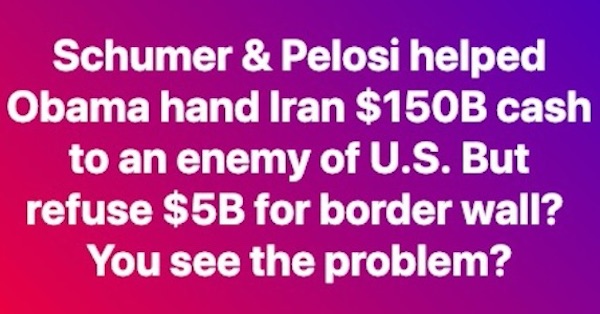As President Donald Trump prepared on 8 January 2019 to deliver a televised speech to the nation making the case for billions of dollars to construct a wall along the roughly 2,000-mile border between the U.S. and Mexico, some social media users circulated an inaccurate meme containing the claim that the preceding Obama administration, with the help of Democratic lawmakers Nancy Pelosi and Chuck Schumer, had given Iran $150 billion in cash.
President Trump battled Congress over his request for $5.7 billion to fulfill a 2016 campaign promise to "build the wall." The resulting impasse over budget appropriations for the wall's construction led to a protracted shutdown of the federal government.
As with many memes, the one above paired two topics that were unrelated to each other, along with a generous helping of inaccuracy. The "enemy of the U.S." referred to Iran, which was never given a $150 billion cash payment by President Barack Obama with the help of Pelosi and Schumer. Instead, billions of dollars worth of Iranian assets were unfrozen as a result of the 2015 nuclear deal negotiated with that country, which had nothing to do with the U.S. federal budget or border wall construction.
Trump floated the "$150 billion" figure in conjunction with his desired border wall construction in a 12 December 2018 Twitter post:
The Democrats and President Obama gave Iran 150 Billion Dollars and got nothing, but they can’t give 5 Billion Dollars for National Security and a Wall?
— Donald J. Trump (@realDonaldTrump) December 12, 2018
The $150 billion figure is an estimate of the value of Iranian assets that were unfrozen as a result of Iran's agreeing to the terms of the nuclear agreement reached with seven nations in 2015, including the U.S., an agreement formally known as the Joint Comprehensive Plan of Action. In other words, Iran gained access to assets that already belonged to them, assets that had been frozen in various financial institutions around the world due to sanctions imposed to curb Iran’s nuclear program. But Iran didn't get $150 billion in cash, nor did they receive any money at all from U.S. taxpayers -- they only regained access to assets that had been frozen in several different countries (not just the U.S.), and the $150 billion figure was merely an upper estimate.
Moreover, that $150 billion figure was the highest estimate of the value of Iran's frozen assets, with multiple sources reporting much lower figures. For example, Adam J. Szubin, Acting Under Secretary of Treasury for Terrorism and Financial Intelligence, supplied written testimony to a U.S. Senate committee in August 2015 stating that U.S. assessment of the total liquid assets Iran would regain control of as a result of the nuclear agreement was "a little more than $50 billion":
We must also be measured and realistic in understanding what sanctions relief will really mean to Iran. Estimates of total Central Bank of Iran (CBI) foreign exchange assets worldwide are in the range of $100 to $125 billion. Our assessment is that Iran’s usable liquid assets after sanctions relief will be much lower, at a little more than $50 billion. The other $50-70 billion of total CBI foreign exchange assets are either obligated in illiquid projects (such as over 50 projects with China) that cannot be monetized quickly, if at all, or are composed of outstanding loans to Iranian entities that cannot repay them. These assets would not become accessible following sanctions relief.
Nader Habibi, professor of economics of the Middle East at Brandeis University, told us via email his best estimate was that between $30 billion and $50 billion of unfrozen funds were made available to Iran as a result of the deal.
On 8 May 2018, President Trump announced that he was pulling the U.S. out of the nuclear deal with Iran, which had been negotiated over the course of two years.


